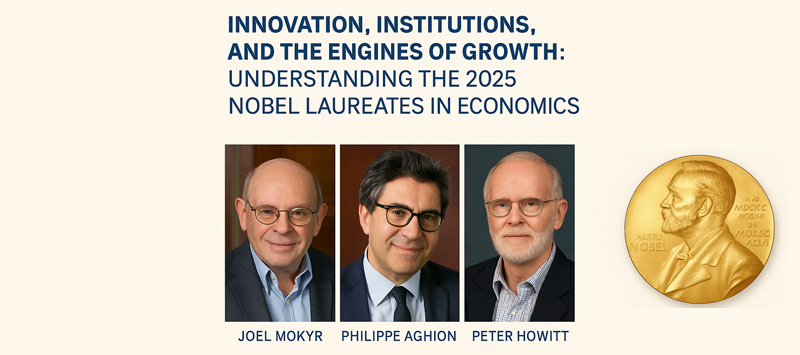
Innovation, Institutions, and the Engines of Growth: Understanding the 2025 Nobel Laureates in Economics
 |
Dr. Syama U S Assistant Professor Department of Economics Kristu Jayanti (Deemed to be University), Bengaluru |
Three economists—Joel Mokyr, Philippe Aghion, and Peter Howitt — were awarded the Nobel Prize in Economic Sciences for 2025 on Monday, in recognition of their groundbreaking work on the nature of forces that power long-term economic growth through innovation and creative destruction. Their collective work has reshaped how economists, policymakers, and historians view technological progress and its relationship with prosperity, productivity, and social transformation.
The Laureates and Their Legacy
Joel Mokyr is a Professor of Economics and History at Northwestern University. He is renowned for his studies on the origins of modern economic growth, as documented in the history books. His research demonstrates how cultural attitudes toward knowledge, invention, and progress in early modern Europe laid the groundwork for the Industrial Revolution. References to Mokyr’s books, such as The Lever of Riches and The Gifts of Athena, underscore the importance of institutions, incentives, and openness to new ideas for sustained technological progress. Schumpeterian model of endogenous growth. Further reading, Philippe Aghion and Peter Howitt at Harvard University and later at Brown University worked on the influential Schumpeterian model of economic growth. Their model codified the idea of “creative destruction,” in which innovation constantly breaks down old things, causes productivity gains, and also overhauls the labour market. As they demonstrated in their pioneering research, which included studies on Endogenous Growth Theory, innovation is not an exogenous shock but an endogenous phenomenon: it emerges from competition, investment planning regimes, and institutional design.
Why Their Work Matters Today
The 2025 Nobel Prize will remind us that it remains as relevant, if not more so, today to understand innovation-led growth for a rapidly changing world. In a digital, AI, and climate-challenged world, their observations of economic vibrancy born through knowledge design and spread are enlightening. Jonathan Ostry, Policymakers have a lot to learn from their efforts. Education, research, and development, as well as competition, indeed are critical to achieving inclusive growth. The way they approach their work straddles economic theory and historical experience, a reminder that progress in technology is not sufficient. The right combination of institutions, incentives, and openness to change determines whether societies thrive or stagnate. Mokyr’s historical lens complements Aghion and Howitt’s formal models, together providing a holistic understanding of how innovation shapes economic destiny.
A Message for Developing Countries and Students
These contributions are particularly pertinent for developing nations such as India. They emphasise that innovation ecosystems, when universities, companies, and governments collaborate, are essential for making the transition from copying to inventing for students of the discipline, whose work demonstrates that integrating history, theory, and empirical testing can yield powerful insights to inform real-world policy. The work of Mokyr, Aghion, and Howitt is a timely reminder that economic growth is not just about addition (or subtraction), but about multiplication —the kind of multiplication driven by human creativity, curiosity, and the courage to embrace change.